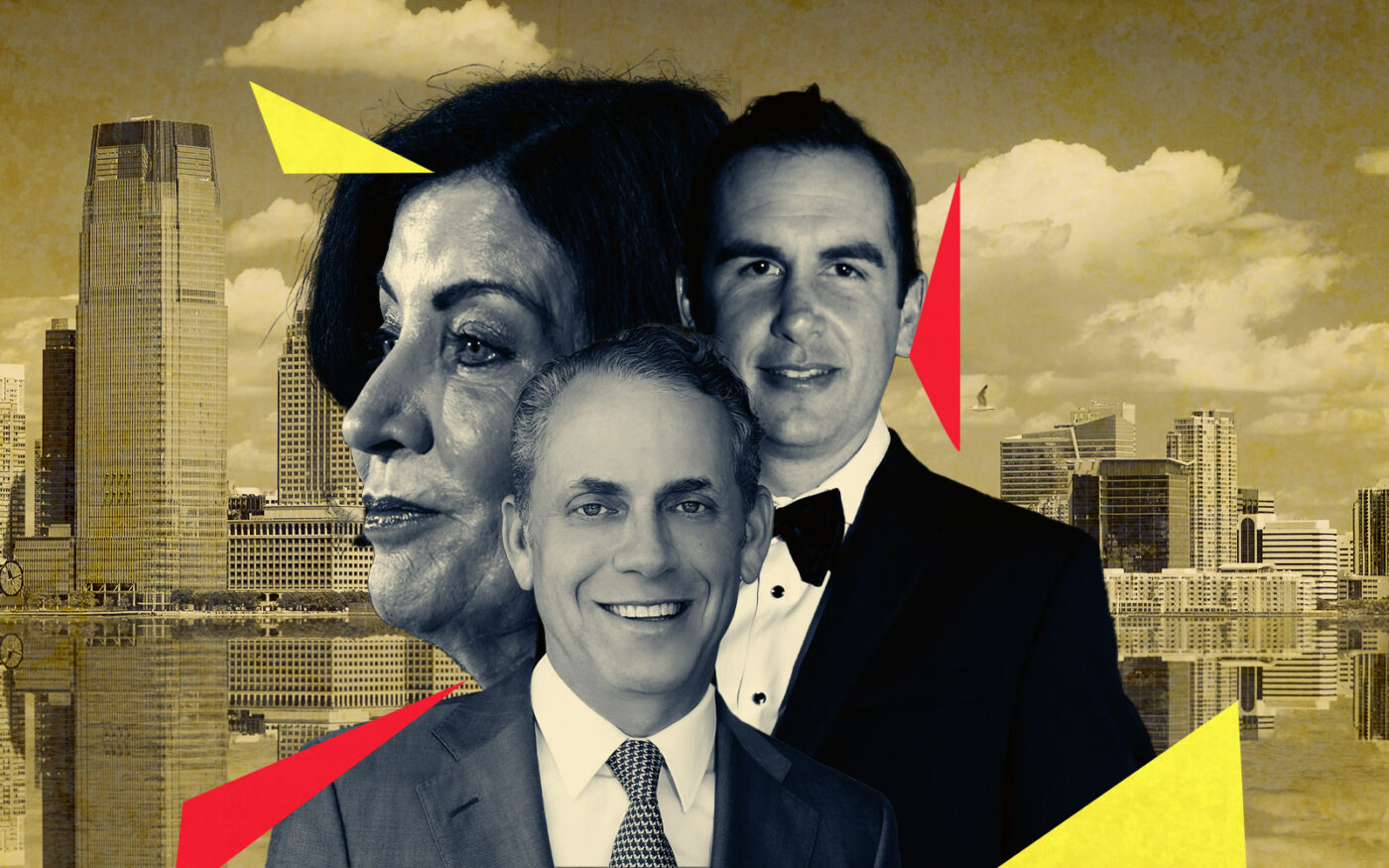Hot property: Jersey City’s development boom
Multifamily projects proliferate as Garden State outbuilds New York

For Bruce Beal, the view from his office at 30 Hudson Yards is a persistent reminder of being late to the party.
Looking west from the 73rd floor, the Related Companies president can see the Jersey City skyline, where glassy towers have rapidly sprouted up along the Hudson River.
Beal acknowledges that Related probably should have built there earlier, though he notes, “We were pretty busy.”
Jersey City development is booming, driven by robust and rising rents and a welcoming regulatory regime. The median asking rent for one-bedrooms listed in New Jersey’s second-largest city was $3,140 in February, according to Zumper — more than in San Francisco, Boston, Miami and every other U.S. city save New York.
Using lease agreements and other data, Apartment List ranks Jersey City rents 10th highest among the nation’s 100 largest cities. Its median rent shot up 17.6 percent in 2021 and 7.8 percent in 2022 before new supply and other factors limited the increase to 1.6 percent last year.
Local officials have embraced growth. Between 2010 and 2022, Jersey City permitted roughly three times as many housing units as New York City per capita, an analysis of Census Bureau and New York City Planning data shows.
Related, which built Hudson Yards, eventually got in on the action, paying a hefty $58 million in October for a 1.3-acre parking lot several blocks from the water. A wall of buildings stands between the site and Manhattan’s more famous skyline, leaving only One World Trade Center visible.
Still, its appeal is obvious: Seven minutes away by foot is the PATH train at Exchange Place, which can get riders to Lower Manhattan in 10 minutes. Across the street, a Whole Foods Market opened last year. And the zoning will allow Related to build nearly 800 luxury apartments.
Other developers of Manhattan’s West Side have also looked across the Hudson and seen opportunity. Tishman Speyer will add two towers with nearly 2,000 units to the Jersey City waterfront. Brookfield Properties just kicked off the second phase of the 5,500-apartment Hudson Exchange.
Tax incentives helped fuel the development of the city’s waterfront, but in recent years officials have become more selective in awarding them. Developers say the boom has been sustained by pro-growth elected officials and reasonable taxes on rental properties. The expiration of New York City’s tax break for rental projects in June 2022 has made Jersey City even more attractive.
Municipalities in other parts of the state have also ramped up their housing production — but in many cases reluctantly, to comply with affordable housing mandates that have been litigated for decades. Because of that resistance, the Garden State is still struggling to keep pace with demand.
“There are some municipalities that are very forward thinking, that want to proactively plan and get ahead of their issues, their needs,” said Debra Tantleff, a Jersey City-based developer who chairs the New Jersey Builders Association. “And there are other municipalities that are very content with the status quo.”
Yes in Our Backyard
Daniel Ridloff describes his company’s interest in Jersey City as “hyperactive.”
SCALE, the lending arm of affordable housing developer Slate Property Group, has provided $700 million in financing in Jersey City, most recently lending $243 million to a pair of apartment buildings planned by the Namdar Group in the Journal Square neighborhood.
“The process is a little more user-friendly in Jersey City,” Ridloff said. “Certainly things seem to be a little bit more development-friendly.”
Its development explosion has been most pronounced in neighborhoods with quick transit access to New York City. But even Jersey City’s West Side, divided by a snarl of Route 9, has seen a spike in interest.
In September, the City Council approved a 30-year tax break for a 210-unit apartment building planned for a former brownfield site on the Hackensack River. It was the first abatement approved by the Fulop administration in six years, according to the Jersey Journal, allowing for some income-restricted units.
The 100-acre site is expected to ultimately have more than 8,000 apartments, 35 percent of them permanently affordable.
“The modern day Jersey City was built on PILOT agreements,” said Jeffrey Gradone, a partner at Archer & Greiner who represents developers seeking such tax exemptions. He said localities such as Jersey City that have moved away from PILOTs, or payments in lieu of taxes, often still consider them for projects that would not otherwise be built.
Jersey City Mayor Steve Fulop, who is running for governor in 2025, frames his administration as pro-development. He contrasts this with New York City’s tortuous land use process, which ultimately gives individual City Council members the power to stop a rezoning.
“Some municipalities that experienced growth are less resistant because they see it is not so bad. All of the myths are starting to be debunked”
“New York City, you have layer upon layer of bureaucracy,” Fulop said. “Jersey City, those don’t exist. There is not the same veto ability from one party.”
Jon Mikula, a broker with JLL Capital Markets’ New Jersey office, said elected officials and localities’ willingness to provide long-term tax exemptions play a major role in encouraging growth. PILOTs replace property taxes with annual payments to municipalities, providing lower and more predictable costs. Localities, for their part, get a bigger chunk than they would by sharing taxes with schools, the county and other services.
“It is all really to make the math work,” Mikula said. “It’s not a giveaway. It is absolutely necessary to provide a return on investment.”
In New York City, where property taxes on rentals are disproportionately high, 421a served that purpose. Its lapse in 2022 lured some developers to New Jersey, which taxes residential property types uniformly.
“The day after the tax break expired, I don’t know how many millions of dollars decided they were going to invest in New Jersey,” Tantleff said. “And then they came over to New Jersey and realized, ‘Wow, this is really different.’”
Growth rules
New Jersey has become a talking point in New York housing policy.
“We have a housing crisis, that if we don’t start building now, we’re going to lose to New Jersey. And how does that feel, everybody?” Gov. Kathy Hochul quipped in January during one of New York real estate’s biggest annual events.
Her comment did not exactly resonate with the audience, which included developers who contributed to New Jersey’s superior housing production.
New Jersey has become a rhetorical rival in the housing debate because it has outbuilt New York and siphoned its residents. Census data show that New Jersey, which has 9.3 million residents to New York’s 19.8 million, issued more housing permits last year than New York for the first time since at least 1990.
Of New Yorkers who left the state between 2021 and 2022 for housing reasons, two-thirds went to New Jersey, according to a report by the Hudson Valley Pattern for Progress.
During that time, 75,103 New York residents moved to New Jersey, behind only Florida, which absorbed 91,201, according to the U.S. Census Bureau’s American Community Survey.
In 2021, “Inner” New Jersey — northeastern counties including Hudson, Bergen, Essex and Union — issued 23,705 housing permits, eclipsing New York City’s 22,606, according to an analysis by the New York City Department of City Planning. That report found that per capita, the city has trailed this part of New Jersey — as well as six of the country’s 10 largest metropolitan areas — since 2012.
In 2022, New York City’s housing permit numbers tripled because developers were racing to beat the expiration of the property tax break 421a. The rate has since plunged.
New Jersey, Massachusetts and Connecticut are — like New York — home rule states, meaning localities can pass laws so long as they do not conflict with state rules. But unlike New York, these states allow developers to go around municipalities that block affordable housing construction.
“New York does stand alone among its peer states that have high housing costs and strong economies in the way that it gives so much more broad authority to its localities,” said Marcel Negret, a senior planner with the Regional Plan Association.
New Jersey’s Mount Laurel doctrine, which stems from a 1975 state court decision, requires localities in the state to contribute their “fair share” of affordable housing. Those that fail to submit plans, or don’t abide by their blueprints, can face “builder’s remedy” lawsuits. Developers file them to get a court’s permission for a project that includes affordable housing.
Jersey City, Newark and other so-called qualified urban aid municipalities — those with zoning that allows significant housing construction — do not have to meet housing targets under the Mount Laurel doctrine. They have nonetheless passed or pursued zoning changes to welcome accessory dwelling units and other types of housing.
Since a 2015 decision ramped up enforcement, Mount Laurel has led to more than 69,000 new homes across 349 municipalities, according to an April 2023 report by the Fair Share Housing Center. Of those, 21,891 were affordable.
“The strongest driver in New Jersey, by far, has been the fair share framework,” Negret said. “Nothing of that nature exists in New York state.”
Trouble with Jersey
In terms of land pricing, taxes and other expenses, building in New Jersey is less expensive than in New York City. But it has its drawbacks. Tantleff said the lack of a streamlined, standardized site plan application, as well as differences in town resources — some municipalities do not have a full-time planning staff — can drag out project timelines.
“The sentiment that New Jersey is a hyperlocal, relationship-oriented development community is very accurate because it is a unique process — every project, every town,” Tantleff said. “Just because you did it this way on this project, in this town, doesn’t mean you are doing it that way in that town.”
Outpacing New York in multifamily construction does not necessarily mean New Jersey is meeting its needs, especially for its most vulnerable residents.
The state requires 220,000 more homes for extremely low income households to meet current demand, according to an analysis by the National Low Income Housing Coalition.
Lawmakers in New Jersey are considering changes to localities’ housing mandates, ahead of the fourth round of plans established under Mount Laurel. Since 2015, the Fair Share Housing Center, a nonprofit that sues towns to force them to meet their housing obligations, has reached settlements with more than 340 municipalities. Other towns are planning ahead.
“More municipalities than not resisted. Now that municipalities experienced some of this growth, some are less resistant to it because they see it is not so bad,” Tantleff said. “All of the myths are starting to be debunked, and you now have a portion of these municipalities that are saying, ‘OK, let’s proactively plan. Let’s control our destiny.’”




